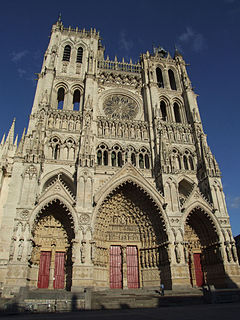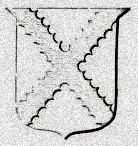Related Research Articles

The Archdiocese of Reims is a Latin Church ecclesiastic territory or archdiocese of the Catholic Church in France. Erected as a diocese around 250 by St. Sixtus of Reims, the diocese was elevated to an archdiocese around 750. The archbishop received the title "primate of Gallia Belgica" in 1089.

The Diocese of Beauvais, Noyon, and Senlis is a Latin Church ecclesiastical territory or diocese of the Catholic Church in France. The diocese encompasses the department of Oise in the region of Hauts-de-France. The diocese is a suffragan of the metropolitan Archdiocese of Reims. The current bishop is Jacques Benoit-Gonnin, appointed in 2010.

The Roman Catholic Diocese of Saint-Flour is a Diocese of the Latin Rite of the Roman Catholic Church in France. The diocese comprises the department of Cantal. Erected in 1317, the diocese was suffragan of the Archdiocese of Bourges until 2002. With the general reorganization of the structure of the French church by Pope John Paul II, Saint-Flour became the suffragan of the Archdiocese of Clermont. The seat of the bishop is located in Saint-Flour, Cantal.

The Roman Catholic Diocese of Amiens is a diocese of the Latin Rite of the Roman Catholic Church in France. The diocese comprises the department of Somme, of which the city of Amiens is the capital.

The Diocese of Nancy and Toul is a Latin Church ecclesiastical territory or diocese of the Catholic Church in France. After a considerable political struggle between Louis XV, Louis XVI, and the Dukes of Lorraine, the diocese was erected by Pope Pius VI on 17 December 1777. The Diocese of Nancy is a suffragan diocese in the ecclesiastical province of the metropolitan Archdiocese of Besançon.

The bishopric of Lavaur was founded by Pope John XXII in his plan to reorganize the sprawling diocese of Toulouse. The town is situated some fifteen miles to the east of Toulouse. Lavaur had the reputation of being one of the strongest centers of Catharism, being referred to as sedes Satanae, atque erroris haeretici primatica ('seat of Satan and prime source of heretical error' The diocese consisted of some 80–90 parishes. It hosted one abbey, that of Sorèz, a convent of the Clarisses, a convent of the Daughters of the Cross, a convent of Dominicans, one of Franciscans, one of Capuchins, two of reformed Dominicans, and two houses of the Doctrinaires. The diocese produced some 35,000 livres for the bishop.

Guillaume Pierre Godin was a French Dominican theologian, and Cardinal.

The Roman Catholic Diocese of Luçon is a diocese of the Latin Rite of the Roman Catholic Church in France. Its see is Luçon Cathedral in the commune of Luçon. The diocese comprises the department of Vendée. Created in 1317 out of the diocese of Poitiers, its existence was interrupted during the French Revolution, but it was restored in 1821, along with the Bourbon restoration.

The former French Catholic diocese of Riez existed at least from fifth century Gaul to the French Revolution. Its see was at Riez, in the modern department of Alpes-de-Haute-Provence.

The former French Catholic diocese of Saint-Pons-de-Thomières existed from 1317 until the French Revolution. Its see at Saint-Pons-de-Thomières in southern France is in the modern department of Hérault. There was the Abbey of St-Pons, founded in 936 by Raymond, Count of Toulouse, who brought there the monks of St-Géraud d'Aurillac.
The former French diocese of Thérouanne controlled a large part of the left bank of the river Scheldt during the Middle Ages. Territorially it was part of the county of Artois which belonged to the county of Flanders.

The Roman Catholic Diocese of Nevers is a diocese of the Latin Rite of the Roman Catholic Church in France. The diocese comprises the department of Nièvre, in the Region of Bourgogne.

The Roman Catholic Diocese of Arras (–Boulogne–Saint-Omer) is a diocese of the Latin Rite of the Roman Catholic Church in France. The episcopal see is the Arras Cathedral, in the city of Arras. The diocese encompasses all of the Department of Pas-de-Calais, in the Region of Nord-Pas-de-Calais.

Nicholas de Balmyle, also called Nicholas of St Andrews, was a Scottish administrator and prelate in the late 13th century and early 14th century. A graduate of an unknown university, he served his earliest years as a clergyman at St Andrews, moving on to hold churches in Lothian as well as deputising to two archdeacons of Lothian.

Pierre Desprès (1288–1361) was a French Cardinal during the period of the Avignon Papacy.

Jean Lemoine, Jean Le Moine, Johannes Monachus was a French canon lawyer, Cardinal, bishop of Arras and papal legate. He served Boniface VIII as representative to Philip IV of France, and founded the Collège du Cardinal Lemoine, in Paris. He is the first canon lawyer to formulate the legal principle of the presumption of innocence.

The Diocese of Lisieux was a Roman Catholic ecclesiastical territory in France, centered on Lisieux, in Calvados.
Pope John XXII (1316–1334) created 28 new cardinals in six consistories:
Jean du Plessis-Pasté, a French prelate of the 14th century, Bishop of Arras and Chartres.

Regnault de Chartres was a French cardinal, archbishop of Rheims, peer of France and chancellor of France during the reign of King Charles VII of France. In 1429 during the Hundred Years' War he anointed and crowned the dauphin Charles king of France in Rheims, thus upholding the Valois dynasty's claim to the French throne against the English claim of King Henry VI of England.
References
- ↑ Pierre de Chappes at GCatholic.org.